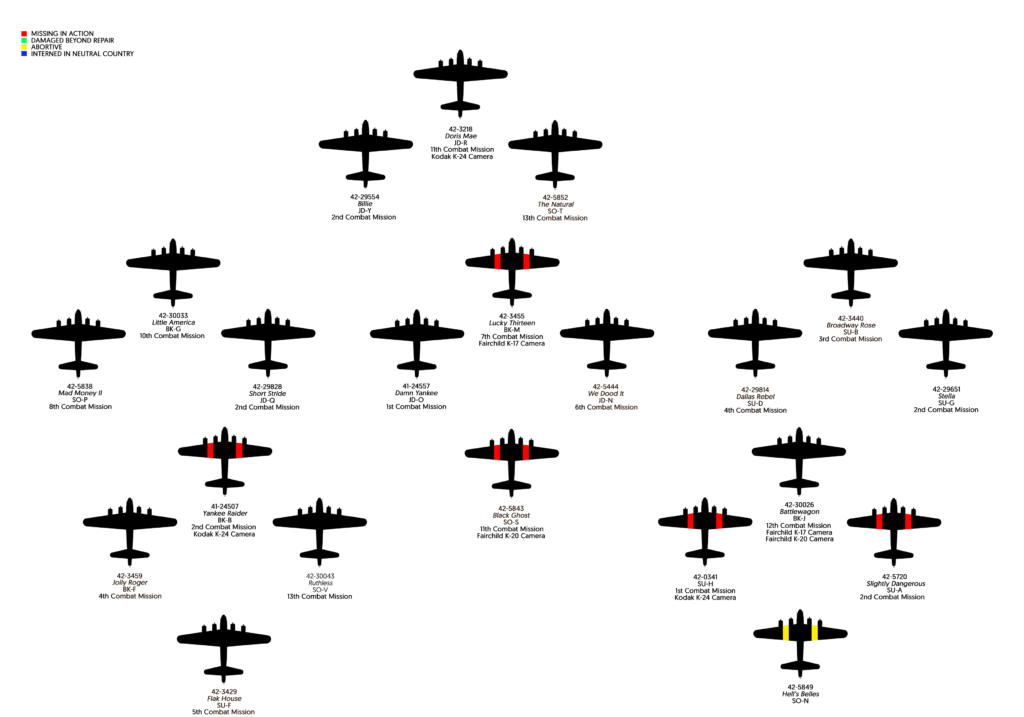77 years ago today, Lucky Thirteen flew her seventh and final combat mission.
6 September 1943
VIII BC No. 91
Ramrod S. 35
384BG No. 21
The US 8AF launches 338 Boeing B-17s against the industrial district of Stuttgart, Germany while 69 Consolidated B-24s fly a diversionary route over the North Sea. The strike is led by CG 41BW BG Robert F. Travis aboard Satan’s Workshop (42-29931, 303BG) and is escorted by 176 Republic P-47s, with additional escort provided by RAF FC. This is the first operation using B-24s since they returned from North Africa and the first deep penetration since the Schweinfurt-Regensburg strike the previous month.
The 384BG launches 21 aircraft – a maximum effort – led by CO 545BS CPT Raymond P. Ketelsen aboard Doris Mae (42-3218). Lucky Thirteen leads the second element of the lead squadron.
The operation proves to be a disaster and the main culprit is gasoline. Most of the fighter units still lack adequate droptanks and weather delays disrupt the carefully planned rendezvous points – common problems in the 8AF. More uncommon however is the disastrous effect the weather delays have on the bombers’s gasoline. Many of the older B-17s lack outer-wing fuel tanks (known as “Tokyo Tanks”), used to extend the bombers’ already considerable range. While bomber range is normally not an issue, the weather delays over Stuttgart cause many bombers (the vast majority of those lost) to run out of fuel on the flight home – largely the result of Travis ordering the force to circle the target four times due to cloud cover.
Even with multiple passes, the strike force fails to sight Stuttgart and all the bombs are either haphazardly dropped through the clouds or on targets of opportunity. The 384BG abandons the strike on the third go-around, with Ketelsen ordering his bombardier (2LT William B. Kinney, Jr.) to bomb a German town visible nearby. Despite reporting his misgivings, Kinney does so and the 384BG rejoins its combat wing. The after-action reports fail to identify the town.
The problems suffered this day prove to be the final straw, with the 8AF not launching another daylight operation against Germany until 27 September. When the 27 September strike takes place, not only are US fighters equipped with 108 gal droptanks for the first time, but the bombers are led by Pathfinders carrying ground-reading radar for all-weather bombing.
The numbers:
| Bombers Launched: | 407 |
| Bombers Effective: | 322 |
| Fighters Launched: | 176 |
| Bombers MIA: | 45 |
| Bombers DBR: | 10 |
| Bombers Abort: | 85 |
| Fighters MIA: | 1 |
| Abort Rate: | 21% |
| Loss Rate: | 14% |
| E/A Destroyed: | 23 |
*Please note that the numbers above come from official US and German sources as victory claims cannot be relied upon. The numbers above do not account for RAF statistics.
Lucky Thirteen is lost on this operation.
While Lucky Thirteen is a newer B-17F with Tokyo Tanks, a flak hit in her right wing results in a massive fuel leak. As such, she drops from the formation upon crossing the Franco-German border on the flight home. Records from the 384BG report seeing Lucky Thirteen feather her No. 1 engine and begin dumping equipment at 49° 29′ N, 04° 00′ E, heading 270°. Shortly afterward, Lucky Thirteen is intercepted by a FW-190, believed to have been piloted by Uffz Franz Kahlhammer of 3/SKG10, northeast of Beauvais.
2LT Harry A. Hawes (bombardier), 2LT Warren B. Holland (co-pilot), TSGT Oscar K. Hamblin (engineer), SSGT Edward F. Ruch (waist), and SSGT William H. Ross (tail) all report minor wounds. 2LT Warren B. Holland (navigator) and TSGT Charles L. Kirby, Jr. (radio operator) are seriously wounded, the latter being unconsciousness. With 1LT Russel R. Faulkiner (pilot) ringing the bail-out bell to abandon ship, Kirby is dropped from the bombbay with his parachute attached. Faulkiner activates the autopilot before jumping and the aircraft crashes in the Bois des Moines just east of the town of Airion, France. Faulkiner, Hawes, and Hamblin are picked up by locals, who smuggle them back home through the French resistance. The other airmen, including Kirby (after a short hospital stay), are taken prisoner.
Of the 30 airmen who flew Lucky Thirteen into combat during her short career, only three were ever seriously injured – SSGT Loring C. Miller on 17 August and 2LT Warren B. Holland and TSGT Charles L. Kirby, Jr. on 6 September. All three survived their injuries. It seems that Lucky Thirteen was indeed lucky.

The crew of Lucky Thirteen prior to going overseas.
(Left to Right)
SSGT Harry Saperstein (Ball Turret)
TSGT Oscar K. Hamblin (Top Turret/Engineer)
SSGT James P. Morley (Waist Gunner)
2LT Richard J. Peirce (Navigator)
2LT Warren B. Holland (Co-Pilot)
2LT Jacques E. Riddel (Pilot)
2LT Harry A. Hawes (Bombardier)
TSGT Charles L. Kirby, Jr. (Radio Operator)
SSGT Edward F. Ruch (Waist Gunner)
SSGT William H. Ross (Tail Gunner)
As was common practice, Riddel, as a new pilot, was made a co-pilot on an older aircraft once arriving in England. He was killed on his first mission, flying aboard Sky Queen (42-30032) on 28 July 1943.
The experienced pilot assigned to Lucky Thirteen was 1LT Russel R. Faulkiner, former co-pilot to Little America (42-30033).

The crew of Doris Mae (42-3218), the 384BG’s lead aircraft this day, pose upon returning from the Stuttgart strike.
CO 545BS CPT Raymond P. Ketelsen is kneeling center in the front row, wearing a white scarf. Left of Ketelsen is 1LT Joseph A. Van der Haeghen. Van der Haeghen was normally Doris Mae‘s co-pilot, but flew this mission in the tail gunner’s position. This practice was common in lead aircraft, having an officer in the tail to keep an eye on formation integrity. As such, it is indeed quite probable that Van der Haeghen was the last person other than Kahlhammer to see Lucky Thirteen in the air.
One of our biggest supporters in rebuilding Lucky Thirteen is Andy Rivera, the loving custodian of Van der Haeghen’s personal collection. We look forward to the day when they can see Lucky Thirteen rise from the ashes.
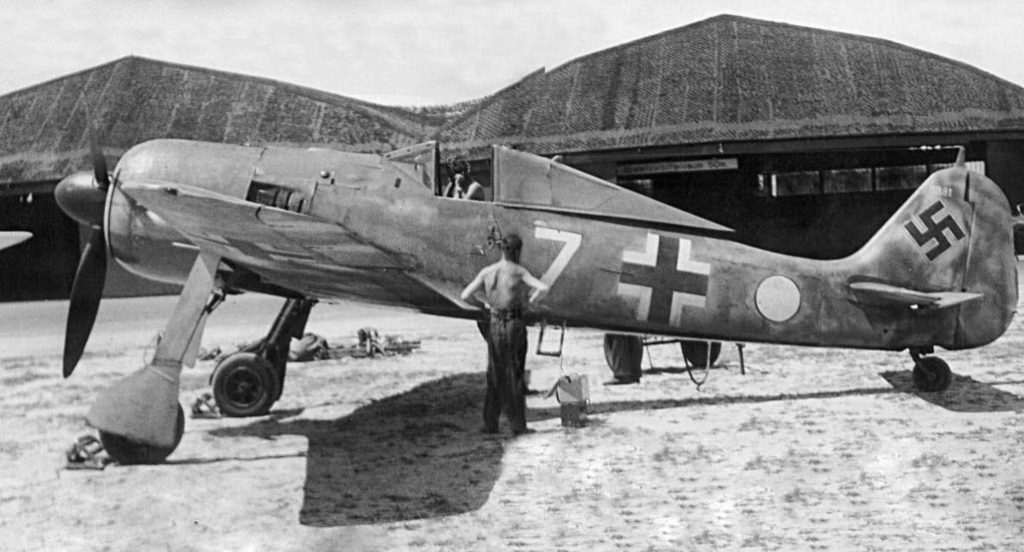
FW-190A “Weiß 7″ (5381, SKG10), piloted by Lt Helmut Wenk. The FW-190 that downed Lucky Thirteen would have looked very similar to this one.
A sign of how desperate the Luftwaffe was becoming in its fight against the USAAF, SKG10 is not a day interceptor unit at all – it is a fighter-bomber unit trained to fly harassment strikes against Great Britain. After action reports from this day’s strike record the use of air-to-air missiles and “formation mines” (bombs set to air-burst over US formations).
An interesting sidenote regarding Uffz Franz Kahlhammer:
While flying FW-190 “Gelb 4″ (840042), Kahlhammer survived being shot down by an RAF deHavilland Mosquito on the night of 21 June 1943. Unlike the US, which set finite tours-of-duty, German aircrews were required to serve for the duration of the war. As such, while some German aces were able to attain incredible numbers of aerial victories, Germany was nevertheless unable to recover from the loss of experienced airmen. Conversely, US airmen who completed their tours usually found themselves serving as instructors at flight schools in the US, sharing their valuable experience.
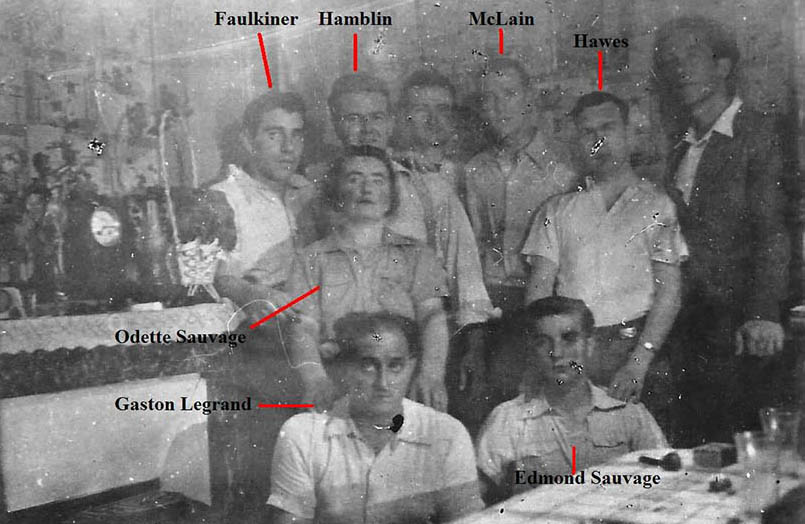
A photo from the Association des Sauveteurs d’Aviateurs Alliés (Association of Allied Aviation Rescuers) showing the three evaders from the crew of Lucky Thirteen.
TSGT Oscar K. Hamblin (Top Turret/Engineer) landed in a pond belonging to Louis Faulon. He and his wife rowed out to Hamblin and rescued him, later burning his clothes.
After landing in a wooded area, 2LT Harry A. Hawes (Bombardier) cut himself down and hid in the loft of a nearby barn. Presenting himself to local apple pickers the next morning, he was given civilian clothes and taken to Paul Corbiere, a local who could speak English.
Having landed safely, Faulkiner presented himself to a local who treated his wounds and gave him civilian clothes. When a guest arrived at the home, Faulkiner fled, hiding in a haystack for the night. Presenting himself to another local, Faulkiner was given another set of clothes and told it was safer to stay inside.
Alongside SSGT Willard D. McLain, ball turret gunner of Black Ghost (42-5843), all three were picked up by Gaston LeGrand, the local butcher, via motorcycle and taken to his home, which sat just a few blocks from the local commandant’s residence. This picture, alongside a list of names and addresses, was shared between the LeGrand-Sauvage family and the airmen, being hidden behind the wallpaper for safekeeping.
The airmen were picked up by French Resistance member Roland “Joseph” Delnef on 10 September and taken to Creil. There they created fake identification cards and were housed in pairs with local sympathizers. On 29 September the group was taken to Paris, where they were placed under the care of Madeleine Melot, again separating into pairs. Faulkiner was the first to leave, joining a group of other evaders on 5 October that were taken to Auzat, crossing the Pyrenees into Spain and arriving in Barcelona on 9 October. Faulkiner returned to England on 29 October, the same day that Hawes and Hamlin reached Barcelona in a similar crossing. Hawes and Hamlin reached England on 18 November, with the BBC broadcasting “Les trois lapins blancs sont bien arrivés” (The three white rabbits have arrived) in acknowledgment of their arrival.
Roland Delnef and Madeleine Melot were later caught and placed in concentration camps, though both survived and were repatriated at war’s end.
The 384BG’s formation chart from this day.
Hell’s Belles (42-5849) aborts when the fairings on one of her turbochargers becomes jammed.
Alongside Lucky Thirteen, the 384BG loses an additional four aircraft – all suffering from fuel exhaustion at the time of their loss: Yankee Raider (41-24507), near Étrépagny, “H-How” (42-0341), near Metz, and Black Ghost (42-5843) and Slightly Dangerous (42-5720) near Beauvais.
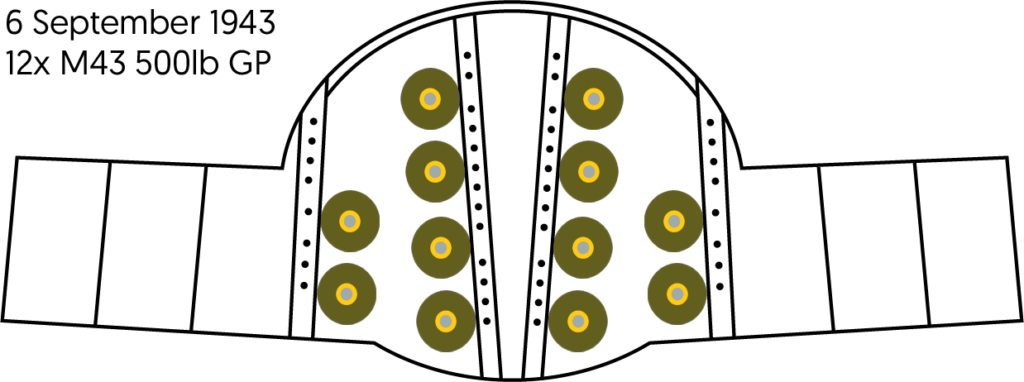
Lucky Thirteen‘s bombload for 6 September 1943.
The AN-M43 500 lb GP bomb was the most common bomb carried by US heavy bombers in the Second World War.

The 384BG’s strike route for 6 September 1943. The target was bombed at an altitude of 24,000 ft. Average temperature was -20 degrees. The blue dot indicates where Lucky Thirteen was shot down.
384BG records claim Lucky Thirteen dropped from formation at 9:45 am and Kahlhammer’s claim records downing Lucky Thirteen at 12:30 pm. Kahlhammer’s timing makes sense when taking into account time zones, as he would have been an hour ahead of the Americans. The US records make less sense. Not only is the 9:45 figure too early by at least an hour, but the coordinates given (49° 29′ N, 04° 00′ E) are at least 20 miles off from where the formation was supposed to be on their return trip.
| Start Engines: | 5:30 |
| Taxi: | 5:45 |
| Takeoff: | 6:00 |
| Feet Wet: | 7:50 |
| Feet Dry: | 8:05 |
| IP: | 9:34 |
| Target: | 9:38 |
| Opportunity: | 10:05 |
| Feet Wet: | 12:15 |
| Feet Dry: | 12:40 |
| Home: | 1:38 |

The US 8AF’s lead bomber on the strike against Stuttgart, Satan’s Workshop (42-29931, 303BG), taken shortly after returning. BG Robert F. Travis is standing second from the right.
Travis formerly commanded I BC, part of a policy set by CG USAAF GEN Henry H. Arnold to bring “new blood” into the US 8AF. Arnold hoped that by moving commanders from training units in the US to the 8AF, it might push them to launch more deep penetrations.
Arnold’s solution had not gone well, as the lack of combat experience resulted in several debacles – the most famous example being the costly 13 June 1943 strike against Kiel, which resulted in the death of CS US 2AF BG Nathan B. Forrest III (grandson of the famed Confederate general). Travis’s thoughts on today’s strike are surprisingly upbeat, though Arnold himself referred to the Stuttgart operation as “a disaster.”
Travis completes 35 missions with the 8AF before he is transferred stateside as a CG 17BW (US 2AF). He is killed in a plane crash on 5 August 1950 while transporting nuclear weapons to the Pacific in reaction to the Korean War.
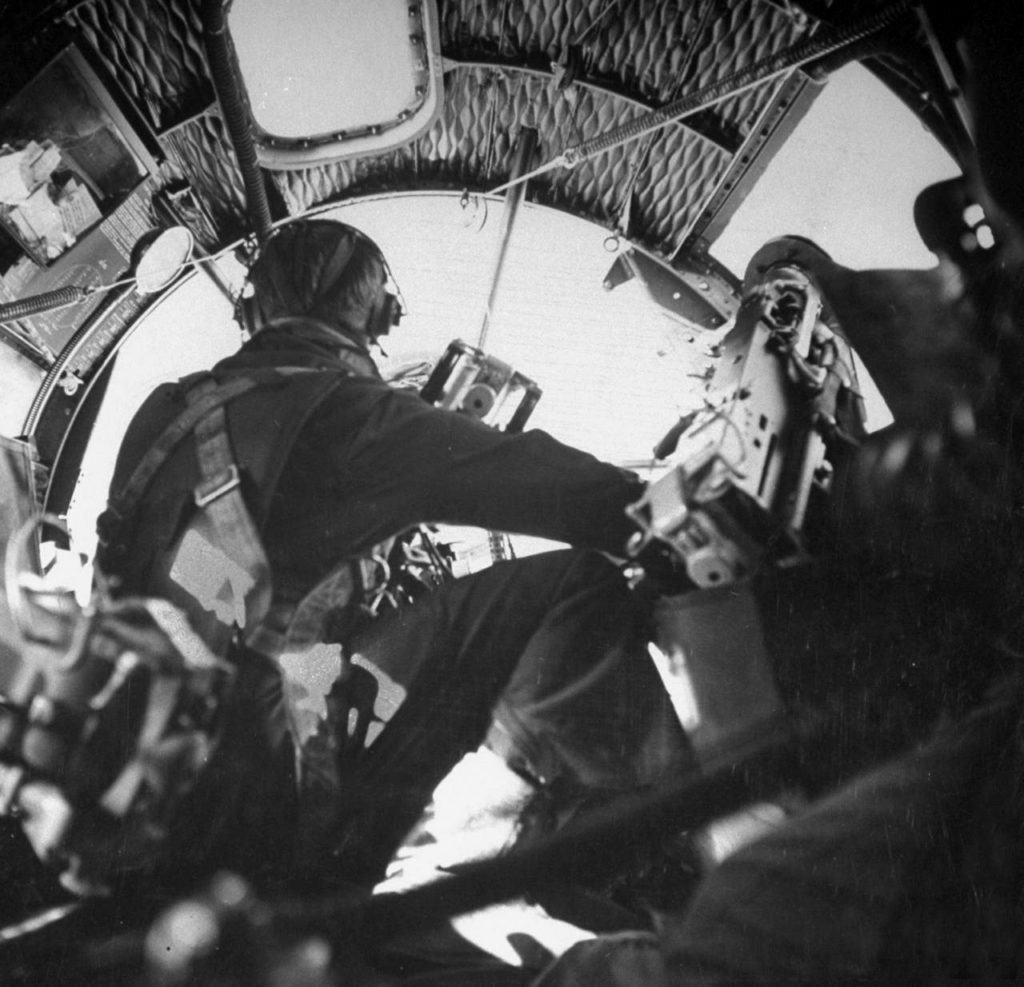
2LT Walter E. Witt in the nose of Winning Run (42-29944, 303BG) on 6 September 1943. Accompanying the crew is Life magazine photographer Frank Scherschel, who takes this and several other high-quality photos.
Note the diamond insulation above the bombardier. The interior batting forward of Station 2 has been removed to allow for the installation of nose and cheek guns. The insulation in the nose is sewn differently than the cockpit and radio compartment (which were tube-stitched) so it could better adhere to the tapered nose.
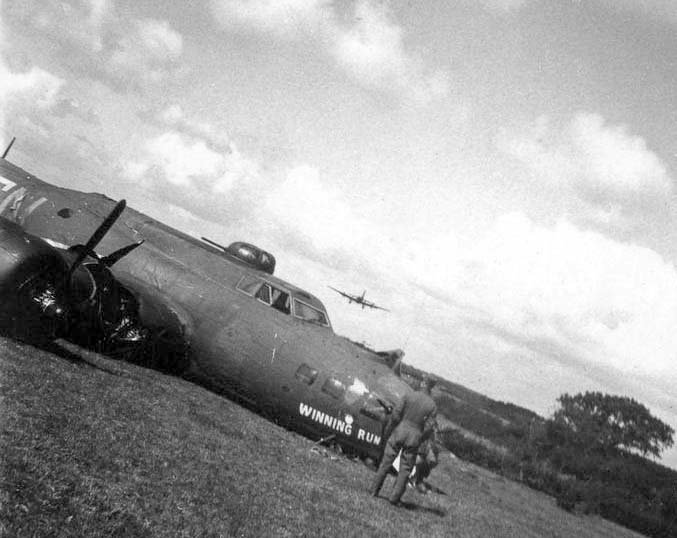
Winning Run (42-29944, 303BG) is one of many aircraft which run out of fuel this day. Having feathered her No. 3 upon Feet Wet, she runs out of fuel trying to land at RAF Deanland – just 14 miles past the English coast.
Photographer Frank Scherschel publishes an account of his ride aboard Winning Run in the 11 October 1943 edition of Life magazine. Naturally, the article does not reveal the reason for the fuel shortage.
Of the 21 aircraft launched by the 384BG this day, five are lost and thirteen make emergency landings at other airfields due to fuel shortage.
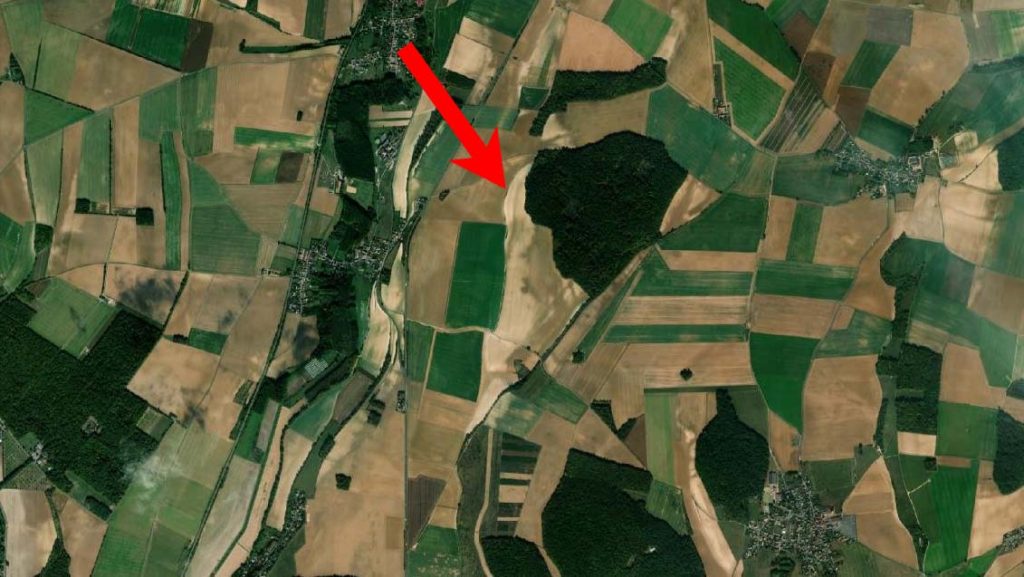
The Bois des Moines (Forest of the Monks) – the location where Lucky Thirteen impacted – is highlighted in this satellite photo the region.
The town of Airion can be see just left of the arrow.

